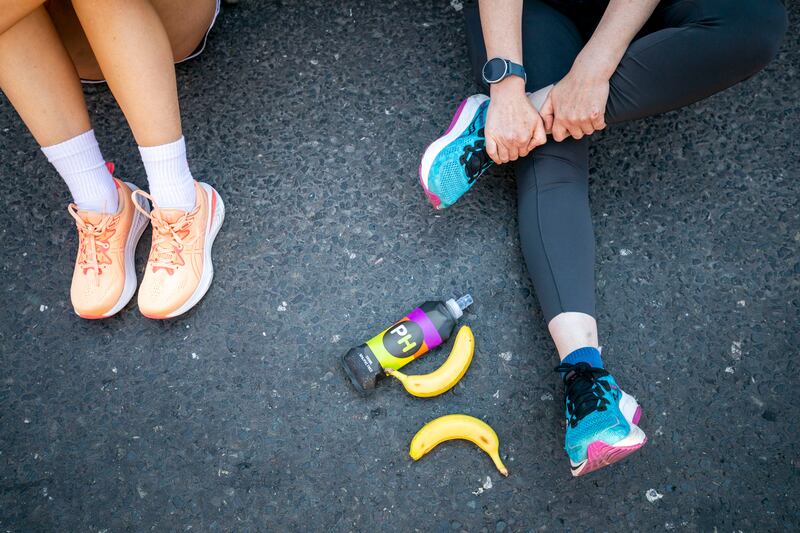All marathon journeys are about reaching your destination: the finish! In the sixth of our monthly series, The Irish Times continues its running lessons to help make that journey a little easier and a lot more fun – all the way to the finish of the 2023 Irish Life Dublin Marathon on October 29th.
Before leaving this mortal world 11 years ago this month Con Houlihan wrote about a great many sporting subjects, including that ancient heroic pursuit known as marathon running. It was, in his old wise way of saying things, roughly equivalent to conquering a horizontal Everest. And he knew what he was talking about.
Because, just like climbers attempting to conquer Everest, marathon runners must also familiarise themselves with their own sort of death zone, which in mountaineering refers to altitudes above a certain point where the level of oxygen is insufficient to sustain human life for an extended time span.
Entering that death zone in marathon running is more commonly referred to as “hitting the wall”, that point in the race, typically around the 32km-mark (20 miles), where the body runs out of standard reserves of energy, as in the glycogen levels in the muscles and the liver, which store about 1,800 to 2,000 calories worth of output, depending in part on how successfully or otherwise the pre-race fuelling plan was adhered to.
READ MORE
It helps to top up those energy reserves during the run, even if only marginally, by way of hydrating drinks and gels. But at some point, late in the race, those glycogen levels will start running on empty.
But how do you know when you’re hitting the wall?
There is a passage in Hunter S Thompson’s Hell’s Angels where he talks about “the edge” and says there is no honest way to explain it because the only people who really know where it is are the ones who have gone over it. It’s similar with the wall because there is no honest way to explain that either. Until you actually hit it.
A report by Prof Barry Smyth from UCD’s Insight Centre for Data Analytics and published in this newspaper a few years back revealed some interesting insights into the wall, his research suggesting men are more than twice as likely as women to hit this marathon-running death zone.
Smyth’s research looked at some 150,000 participants in the Dublin Marathon over the course of a decade, and he found that women and older runners (regardless of sex) were more disciplined when it came to planning and pacing their race. Less experienced male runners were far more likely to set off too quickly and suffer for it in the closing stages.
Smyth reckoned men are two to three times more likely to hit that dreaded wall around that 32km-mark, meaning, as he also defined it, that these runners suffer a 30 per cent decline in pace over those late 10 or so kilometers of the race.
So the most important thing to know about the wall is accepting it, knowing that it’s coming at some point during the run, and therefore how to best get over it. The critical fact in Smyth’s report was that runners who start out faster than their average race pace will invariably hit it the hardest.
However, he also found a surprisingly high number of runners ran their final 10km at a pace above the average speed, which suggested some runners had failed to reach their potential finishing time because they had started out too cautiously.
It’s a fine line, in other words, between starting out too fast and too cautiously. Most runners, it seems, do empty that energy tank too early, especially when running their first marathon. About 65 per cent of first-time marathon runners, compared with about 20 per cent of those who return to race the classic distance for even a second time.
One more daunting finding in Smyth’s report was that while overall only about five per cent of runners hit the wall properly hard – as in it slowed them to a walk or a vastly reduced running pace – this likelihood of hitting the wall was much higher for those finishing in more than 4½ hours. For example, 20 per cent of men who finished in five hours hit the wall.
Still, there’s no easy way to explain that to anyone who has yet to hit the wall for themselves, which is the only real way to understand it.

Do
There is no such thing as any short cut in the marathon, only the 42.2km (26.2 miles, or 138,000ft) between the start and the finish.
There are no short cuts in the training either, so if at this point a week or two has gone by without the planned amount of running, don’t rush back into it either.
If there is any sudden or indeed lingering pain, now is the time to stop and get it checked out by a physiotherapist.
As important as it is to keep a running diary, do remember what Noel Carroll, the co-founder of the first Dublin Marathon in 1980, always preached.
So much of what Carroll achieved during his own career came from the heart of distance running, and when it came to the art itself, he lived by his first and most lasting mantra: “You either ran today or you didn’t.”
At his home village of Annagassan in Co Louth there is memorial seat with another of his quotes – “There’s a time to train and a time to rest; it is a true test of the runner to get them both right” – which for every runner I know still has lasting purpose and meaning.
Don’t
Go too hard on the calf muscles. It’s hardly surprising that the most common injury to marathon runners is the simple calf muscle strain.
During most activities such as long-distance running the calf muscles may need to generate up to nine times the body weight force, during which a weak calf muscle is susceptible to minor muscle tears.
There are two calf muscles located at the back of the lower leg, namely the gastrocnemius and the soleus. The gastrocnemius is the larger muscle bulk, situated higher in the calf, while the soleus is located beneath and below the gastrocnemius. Together, these muscles merge and connect to the heel through the Achilles’ tendon, another obvious spot for running pain.
Most calf muscle injuries are caused by sudden fast movements or missteps. If the muscle is stretched while it is being asked to produce force, it can lead to a minor tear, causing pain and swelling.
The RICE (Rest, Ice, Compression and Elevation) method is recommended when such an injury occurs. But don’t worry about stretching during the early stages of healing, as a calf tear requires both ends to knit back together.
Targets
These have been ongoing in the form of the Irish Life Dublin Marathon race series, which act as a perfect way to establish your expected marathon finishing time.
Gone already are the Corkagh Park 5 Mile (on June 18th) and the Fingal 10km (on July 16th), and next up are the Frank Duffy 10 Mile on August 19th, and, finally and most importantly, the half marathon on September 23rd.
Each race is spaced a month apart, ideally timed to stay on a target, and come the half marathon in September you should have a fair idea of what your target marathon finish time should be.
The half marathon also takes in a part of the Dublin Marathon route in the Phoenix Park, so that’s also good prep work. Effectively a month out from the race day, it’s ideal timing too in terms of pre-race routines and fuelling and also experimenting with any new running shoes.
Because one thing is certain: if you can’t run a half marathon in running shoes that feel comfortable and reasonably well worn in, there is little hope of finding any joy in the full marathon.
For Dublin Half marathon entry see https://irishlifedublinmarathon.ie/race/dublin-half-marathon/

















